Eastern Box Turtle: Slow Moving Stay-at-Homes

Photo by Kathy Wright Hardy
BRNN Nature Notes June 2016
by Linda Martinson Certified Blue Ridge Naturalist
It is fairly common to see box turtles in WNC, minding their own business, plodding along in our meadows, forests, and trails and resting on roads and driveways. All turtles, and especially terrestrial turtles, are among the longest lived and slowest reproducing species in the entire kingdom Animalia. Our turtle is a sub-species of the eastern box turtle (Terrapene carolina carolina), which is the only terrestrial turtle species in the eastern United States and the state reptile of North Carolina. They are called box turtles because their plastron or flat bottom shell is hinged and both sides can be raised to completely close off their domed top shell or carapace.
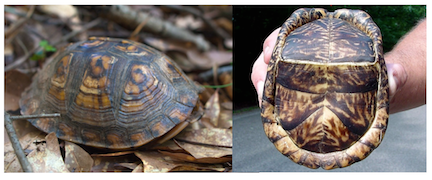
Photo credits: Justin Montegraphia and Fritz Geller-Grimm
Eastern box turtles can live in a wide variety of habitats, but they seem to prefer to live in deciduous or mixed forested regions with a well drained, moderately moist forest
floor. They are also commonly found in open grasslands like pastures and under logs and wet leaves or dirt. There are only six species of box turtles world wide and two of these species, eastern and western box turtles, are native to the United States. The eastern box turtle has four sub-species with the box turtles in our area being the most common and having the same name as the species (Terrapene carolina carolina). Their range is marked in orange in the map below.
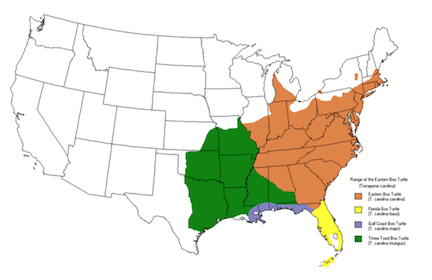
Image from Davidson College Herpetology Lab
Our native eastern box turtle has highly variable colors, but it is usually more brightly colored than any other subspecies and has four toes on its back feet and five on its front feet. Unlike most reptiles, it is easy to tell whether a box turtle is a male or a female. First, check its eyes—all female turtles have yellow or brown eyes, and most males have red eyes.

Photo credits: Steve O’Neill from Earthshine Lodge (male) and Wikipedia (female)
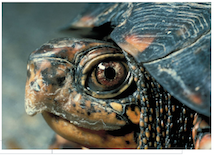
To be completely sure, pick it up (gently) and look at the shape of its pastron. Female box turtles have a completely flat plastron, but the plastrons of the male turtles are all concave or cupped, the better to facilitate mating with high domed shells. Box turtle shells are made of bone covered by living vascularized tissue and then a layer of keratin, the same fibrous protein in hair, feathers, fingernails, claws, etc. If not damaged severely, their shells can reform after an injury and grow back.
Box turtles have a low metabolic rate and can slow their metabolism and heart rate to hunker down to hibernate in the winter, for example, by burying themselves a foot or two deep in loose soil. They can also bury themselves in mud to wait out droughts or forest fires. The turtles come out of hibernation in March or April, depending on the weather, and the males start searching for a mate. Females can store sperm after mating for more than one year. If they do lay eggs, it is in the early summer and in a carefully camouflaged shallow nest with usually 4 to 6 soft, leathery white eggs that hatch about two months later. Before they lay their eggs, the females get restless and begin searching for a suitable place to dig a nest. Between searching for mates and for nesting locations, box turtles are on the (slow) move during the spring and early summer. Sadly, they often blunder around trying to cross roads and driveways and are frequently killed by cars. Nests are also vulnerable—turtle eggs are a favorite treat for raccoons, for example. The hatchlings are only about an inch long and very secretive, seldom leaving the vicinity of their nest for the first year or two. Their shells don’t fully protect them until they are about five or six years old and about 4 to 6 inches long, which is usually their mature size.
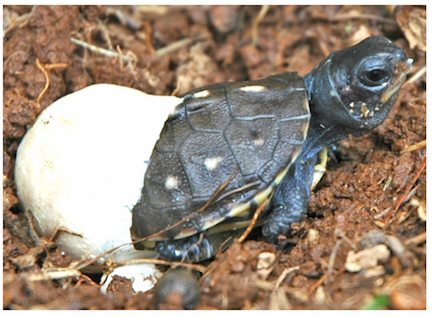
Photo credits above and below: Liam McGranagan, posted in Wikapedia
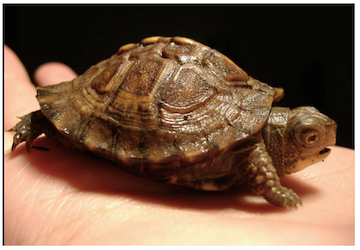
It is surprising that there are any box turtles left, and their numbers are dwindling steadily, primarily from being hit by cars, mowers, and tractor and from habitat destruction and fragmentation. An estimate in 2011 by the International Union for Conservation of Nature and Natural Resources (IUCN) indicated a widespread and persistent decline of their population with a loss of at least 32% over the past three generations, and box turtles are now listed as “vulnerable” instead of “near- threatened”. Box turtles are slow-moving without any strategies to avoid trouble except retreating into their shells. They also have poor pursuit-movement abilities; their eyes only look down at objects on the ground ahead of them. They don’t have teeth, just jagged ridges on their jaws to chew their food. Also, unlike most reptiles, they cannot stick their tongues out to catch food, so they can only use their rigid beaks to pull food into their mouths—and only from right in front of them near the ground. Box turtles mostly stay in a distinct home range, only about 250 yards in diameter, with familiar trails, food and water sources, and wintering locations. If they are removed far from their home range, they generally just wander around aimlessly until they starve to death. Box turtles don’t reach sexual maturity for 7 to 10 years, and don’t always breed annually. It is estimated that a female box turtle may successfully reproduce only one or two adult turtles during their life span, which can be quite long—up to 70 to 100 years.
In their evolutionary history, however, box turtles have apparently made some successful trade-offs, because their morphology has changed very little since the earliest fossil records from about 15 million years ago. This is probably because they are a generalist species with built-in protection from their shells, able to survive in varied habitats and with a large and varied diet. Box turtles are omnivores, and will basically eat anything they can catch including a wide variety of plants and fruits, insects, earthworms, slugs, and carrion — they have even been known to eat live birds caught in low nets. Their favorite food seems to be mushrooms, even those poisonous to humans. Once they are big enough to close themselves completely into their shells, box turtles have few predators and unless they are killed by cars or in some other mishap they can live a long time, aging very slowly. Unlike most other animals, a turtle’s organs do not gradually become less efficient and break down over time. The liver, lungs, and kidneys of a turtle nearly 100 years old are virtually indistinguishable from those of a much younger turtle, inspiring researchers to begin searching the turtle genome for longevity genes. Finally, it’s not likely you will ever have a chance to speak of this, but a group of turtles is known as a bale.







97 comments